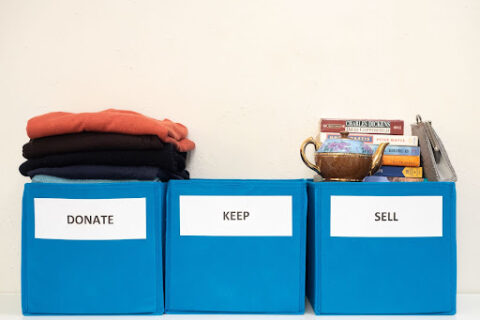Having a garage sale is a great way to get rid of your stuff before a move. Plus, it’s always nice to make a little extra cash. Getting started and setting prices for your belongings can be a bit of a challenge. On one hand, if you price items too high, no one will buy anything. If you price them too low, you may miss out on making a larger profit.
Not only that, but you could easily miss out on a hidden gem or sought-after relic that could bring in some major cash. That’s why we’ve provided a few helpful tips to accurately price your garage sale items.
1. Do Your Research

Research is key in ensuring your prices are fair. Research will also help you get a grasp of the potential demand for your items—trends are constantly changing and you may unknowingly be sitting on the latest fashion or collectible.
Here’s how to research the value of your items:
- Make a list of everything you plan to sell. You don’t need to list out individual titles of books or movies. Just know what categories, and how many titles in each category, you’re looking to get rid of. This will give you a clear view of your inventory.
- Browse similar sales. Look through Facebook Marketplace, local thrift stores or other yard sales to get an idea of what similar items are being sold for. Make note of the prices and inventory. If you see a lot of DVDs or books being sold at higher prices, consider lowering the price in order to ensure they sell.
- Check eBay, Etsy and Amazon for high-value items. Collectibles and vinyls can often sell for a lot more than you think. Sometimes you’re going to be better off listing a high-ticket item online rather than at your garage sale.
2. Price Everything by Category

Grouping things by category will help you simplify the process. Once you have an idea of how much money specific items are being sold for locally, you can easily assign each category a price and go from there.
For example, if baby clothing around your area has been selling for $1-3, you can set the cost for all your individual baby clothes as $2 or $3 depending on the quality. You can even entice buyers by bundling groups of like-items and selling them together at a lower cost.
Let’s say you have five newborn onesies that you valued at $2 each. Instead of selling them individually, you could group them together and sell the lot for $8. This gives the customer a “bargain” and allows you to clear out your shelves more quickly.
- Paperback books: $1
- Hardback books: $2
- CDs: 50¢
- Cassette tapes: 25¢
- Vinyl records: $1 to $10
- DVDs: $1
- VHS tapes: 50¢
- Board games: $2 to $5
- Jigsaw puzzles: $1 to $2
- Toys: $1 to $3
- Baby clothing: $1 to $3
- Children’s clothing: $2 to $5
- Adult clothing: $5 to $10
- Shoes: $5 to $10
- Coats and jackets: $7 to $15
- T-shirts: $1
- Coffee tables: $20 to $50
- Loveseats: $50 to $150
- Couches: $75 to $300
- Dining tables: about $100
- Dining chairs: $15 to $30 each
- Dressers: $30 to $75
- End tables: $25 to $75
- Bookshelves: $15 to $50
- Baby furniture: $25 to $100
- Lamps: $5 to $20
- Wall mirrors or artwork: $30 to $100
- Picture frames: $2 to $10
- Home décor knickknacks: $1 to $5
- China: $1 to $5 per plate
- Dishes and glasses: 50¢ per piece or $5 to $30 for a set
- Flatware: 25¢ per piece or $5 for a set
- Kitchen supplies: $1 to $3
- Small appliances: $5 to $20
- Medium appliances: $25 to $150
- Large appliances: $100 to $400
Don’t be scared to bargain with people. Or, if your main goal is to get rid of your stuff, lower the cost if someone seems apprehensive about a certain item or price.
3. Mark Prices Clearly
After you’ve settled on your pricing strategy, you’ll want to start marking each item. Make sure you’re labeling each price on masking tape, not stickers. While common in yard sales, stickers easily fall off clothing or oddly shaped items and can adhere to solid surfaces, which could damage items and decrease their value.
If you have a large pile of items that you’ll be selling, write the costs associated with that category on a sign and place it near the items. This saves you time marking everything and will help your customers easily understand the pricing metric.
For example, if you’re selling books but have different costs for hardcover, paperback and children’s books, you should just put a sign up listing all three costs.

4. Organize Your Displays
It is important that your sale is easy to navigate. Customers will likely buy more if similar items are next to each other. Keep clothing next to each other, games and toys together and kitchen utensils with appliances or hardware.
You’ll also want to promptly display items that you consider to be fast sellers or high-value in easy-to-see places. Don’t hide away the gems of your sale, get them up front and center so people can find them, buy them and appreciate them.
Next Step: Make Your Move with Bekins Van Lines
With the tips above, you’re ready to host a successful garage sale. You may also want to consider donating any items that are leftover to your local shelters or thrift stores. Downsizing your belongings is going to make your move so much easier! The next step in ensuring a smooth move: Bekins Van Lines. Get in touch with us! Our experts will do the heavy lifting so you can sit back and enjoy your fresh start and new space.


